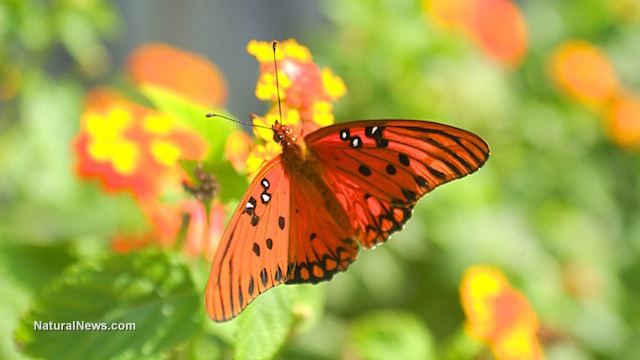Neonicotinoids to be banned in American Northwest and Hawaii in effort to save pollinators
Thursday, July 31, 2014 by: Julie Wilson
Tags: neonicotinoids, pollinators, American Northwest

- TAKE IT DOWN Act advances in Congress amid free speech concerns
- Survival 101: Dangerous places to avoid when disaster strikes
- Gardening tips: 15 Simple tricks to double your garden’s yield this season
- Hospital staffers sound alarm after 10 nurses were diagnosed with BRAIN TUMORS
- Widespread social and economic unrest: Steve Quayle issues urgent financial warning of imminent asset collapse in new interview with Mike Adams
- Criminal referral requests filed against Fauci and top COVID officials in seven states
- Analysis: The coming economic collapse, a mass uprising and Trump's three secret weapons to halt the growing revolt
- Aerosolized bioweapons? Strange “diploid biomasses” falling out of the sky in Florida captured under the microscope
- Fauci is back in the limelight, and he’s busy promoting a future COVID or FLU pandemic
- Israeli lobbyists boast of controlling US national security policy in leaked AIPAC audio
- New studies ignite debate: Fluoride linked to autism and ADHD, prompting calls for policy reassessment
- DOJ and ATF kill Biden’s “Zero Tolerance” firearms dealer policy
- Tulsi Gabbard leads charge against the Biden regime’s global censorship of the 'Disinformation Dozen'
- “Prepare Tribe: Prepare, Protect, Provide” on BrightU: How to build a disaster-proof shelter in the middle of nowhere
- Federal appeals court authorizes DOGE access to Education, Treasury and OPM records
- Kiss Your Genetic Privacy Good-Bye! 23andMe Gets Green Light to Sell Your Intimate Genetic Details to Anyone They Want
- Sovereign debt paradox: U.S.-China mutual holdings fuel geopolitical tensions
- Mike Adams releases country western hit single: Goin’ Back in Time is Comin’ Home
- Tulsi Gabbard leads charge against the Biden regime’s global censorship of the 'Disinformation Dozen'
- Fauci is back in the limelight, and he’s busy promoting a future COVID or FLU pandemic
- Aerosolized bioweapons? Strange “diploid biomasses” falling out of the sky in Florida captured under the microscope
- Analysis: The coming economic collapse, a mass uprising and Trump's three secret weapons to halt the growing revolt
- Widespread social and economic unrest: Steve Quayle issues urgent financial warning of imminent asset collapse in new interview with Mike Adams
- Kiss Your Genetic Privacy Good-Bye! 23andMe Gets Green Light to Sell Your Intimate Genetic Details to Anyone They Want
- Tulsi Gabbard takes aim at censorship: Justice for the ‘Disinformation Dozen’
- Mike Adams releases country western hit single: Goin’ Back in Time is Comin’ Home
- U.S. lawmakers investigate Meta over alleged China collaboration
- CLOT SHOT PLANDEMIC UNFOLDING: Fibrous, rubbery clots caused by covid injections have prion-like seeding activity
- Chemtrails unveiled: How the CIA and Big Business are manipulating the weather for profit
- How Israeli military-connected corporations are secretly controlling your online privacy
- European Court of Justice: Healthcare professionals who promoted or administered COVID-19 vaccines are CRIMINALLY LIABLE for any harm caused
- DEATH by VACCINE or face PRISON time: Canadian Freedom Convoy leaders CONVICTED for protesting forced vaccination during the Covid Plandemic
- Defunding DEADLY mRNA jabs: Government funding for mRNA technology being scrutinized and sidelined until proven "safe and effective" for real
- Federal employees whine over DOGE's new directive requiring them to do a 5-point summary of weekly accomplishments
- U.S. approves new Russian ambassador as diplomatic thaw continues
- Curcumin’s ancient healing power supercharges muscle recovery, and its effects are compounded with anti-inflammatory foods and supplements
- Newly released JFK files reveal Pentagon's role in creating Lyme disease and covid in the same lab
- Analysis: The coming economic collapse, a mass uprising and Trump's three secret weapons to halt the growing revolt
- Mike Adams releases country western hit single: Goin’ Back in Time is Comin’ Home
- Aerosolized bioweapons? Strange “diploid biomasses” falling out of the sky in Florida captured under the microscope
- Kiss Your Genetic Privacy Good-Bye! 23andMe Gets Green Light to Sell Your Intimate Genetic Details to Anyone They Want
- Dr. Mike Yeadon releases 15-minute testimony - WATCH - about genocidal intent of COVID “vaccines”
- Trump reverses course on Gaza plan, says “nobody is expelling Palestinians”
- MEDICAL BOMBSHELL: FDA admits Covid mRNA 'Vaccines' CAUSE CANCER
- European Court of Justice: Healthcare professionals who promoted or administered COVID-19 vaccines are CRIMINALLY LIABLE for any harm caused
- The Health Ranger releases “Vaccine Zombie” song and music video, using AI-animated zombies for the music video
- 5 Simple steps to boost your brainpower: How to strengthen executive function in a distracted world
- A lack of integrity in Academia: Harvard professor found GUILTY of fraudulent research to promote CRT theory
- Federal employees whine over DOGE's new directive requiring them to do a 5-point summary of weekly accomplishments
- EPA advisor admits the agency is funneling billions to climate groups ahead of Trump’s return to White House
- California's social media censorship law struck down: A victory for free speech or a threat to online safety?
- Space war brewing? Russia threatens to destroy Starlink satellites
- Survival 101: Effective EMF blocking techniques
- Rep. Nancy Mace introduces bill to ban biological males from female facilities on federal property
- Red Cross issues warning to stop blood plasma donations from vaccinated people
- Scientists confirm: GENIUS brain function can be spontaneously unleashed in humans without any apparent cause
- EPA advisor admits the agency is funneling billions to climate groups ahead of Trump’s return to White House
- HYSSOP: What research reveals about the health benefits of this ancient holy herb
- Two containers with completed ballots fall out of truck in Florida
- Newly released JFK files reveal Pentagon's role in creating Lyme disease and covid in the same lab
- Global leaders unite to clamp down on “misinformation” with UN-backed Cascais Declaration
- BREAKING: 2025 NDAA authorizes mandatory military draft of WOMEN across America… as Pentagon pursues global NUCLEAR war with both Russia and China at the same time
- Michael Yon warns of a ZIONIST TAKEOVER in Trump’s second administration
- Ozempic and Wegovy weight loss drugs are injectable LIZARD VENOM PEPTIDES that may unleash a devastating wave of organ failure… side effects align with symptoms of SNAKE BITES
- The Health Ranger releases “Vaccine Zombie” song and music video, using AI-animated zombies for the music video
- Mike Adams releases country western hit single: Goin’ Back in Time is Comin’ Home
- BOMBSHELL: DNA testing kits are a SCAM to develop ethnic-specific bioweapons
- Israeli soldiers accused of even more torture and abuse in the West Bank
- These 13 countries just signed an agreement to engineer a global FAMINE by destroying food supply
- NASA admits that climate change occurs because of changes in Earth’s solar orbit, and NOT because of SUVs and fossil fuels
- Fully vaccinated about to see “tsunami” of illness and death, warns virologist
- RFK Jr. clears key hurdle: Sen. Susan Collins backs controversial HHS nominee, signaling a new era for health policy
"We made the decision because we are concerned over the global decline in all pollinators -- bees and butterflies," said U.S. Fish and Wildlife Service spokeswoman Miel Corbett.
By 2016, the agency plans to have completely phased out neonicotinoids, or neonics, for agricultural use throughout Region 1, or the Pacific Northwest. Parts of Region 1 include Hawaii, Idaho, Oregon and Washington (click here for map).
"The Center for Food Safety and Center for Biological Diversity had petitioned Fish and Wildlife to ban neonicotinoids on wildlife refuges nationwide, but agency spokeswoman Miel Corbett said the decision was made independently," reported SFGate.
The U.S. Fish and Wildlife Service said they "inadvertently" use neonics on agricultural crops that are fed to wildlife.
Neonicotinoid family hurts insects, birds and other animals
Seven chemicals make up the neonicotinoid family, and all are known to be toxic to the environment, creating a host of problems for species unfortunate enough to come into contact with the insecticides.
"Neonics are toxic by creating a non-reversible binding action in the nervous system of the invertebrate or vertebrate," according to a report by U.S. Fish and Wildlife.
The poison is distributed systematically throughout the plant's entire vascular system and is often applied as a seed coating prior to planting corn and soybeans.
Further documents by the agency confirm their beliefs that neonicotinoids are creating a significant decline in not just bee populations but a variety of pollinator insects.
Scientist say bees and other pollinators are exposed to neonics through pollen, water droplets on the surface of plants and dust that is released into the air when coated seeds are planted.
"These effects cause significant problems for the health of individual bees, as well as the overall health of bee colonies," said the agency.
Other studies have found neonics to be affecting earthworms, beetles, flies and aquatic invertebrates, and if consumed, can be fatal for birds and mammals.
In their announcement earlier this month, the U.S. Fish and Wildlife Service acknowledged that neonics pose a dangerous threat to entire ecosystems and remain persistent in the environment for extended periods of time.
It only takes 10 nanograms per liter of water for some of the chemicals in the neonic family to kill aquatic life. Bioaccumulation in soils also has some researchers concerned.
The agency admitted that prophylactic seed treatments don't always fulfill the promise of providing more yield, and in turn are "thereby challenging the true agronomic value of these treatments where the environmental costs may outweigh the agricultural benefits."
Month of July proves to be groundbreaking for neonic research
The United States Department of Interior made the announcement to ban the insecticide just 20 days before the U.S. Geological Survey (USGS) released findings about neonicotinoid pollution in rivers and streams throughout the Midwest.
USGS researchers tested nine rivers in the Midwest during last year's growing season and found high concentrations of neonics in 100 percent of their water samples.
The Mississippi and Missouri Rivers were among the nine rivers and streams tested by the researchers; plus, most of the rivers that drain from Iowa and parts of Minnesota, Montana, Nebraska, North Dakota, South Dakota and Wisconsin were studied, all states with the highest levels of neonicotinoids in the nation.
The U.S. Fish and Wildlife Service intends to reduce pesticide drift to prevent contamination in nearby fields. The agency said no residue seeds can be left above ground on refuge lands for birds and other animals to eat, and random field spot checks will be performed at the time of planting to ensure compliance.
The refuge must also maintain a minimum of a 50-foot treatment buffer to water on all non-erodible fields, and a 100-foot treatment buffer to water on all erodible fields that use neonicotinoid-treated seeds.
Additional sources:
http://www.beyondpesticides.org
http://www.usgs.gov
http://www.centerforfoodsafety.org [PDF]
http://www.sfgate.com
http://www.fws.gov
http://science.naturalnews.com
http://science.naturalnews.com
http://science.naturalnews.com
Neonicotinoids at FETCH.news
Get independent news alerts on natural cures, food lab tests, cannabis medicine, science, robotics, drones, privacy and more.
Take Action: Support Natural News by linking to this article from your website
Permalink to this article:
Embed article link: (copy HTML code below):
Reprinting this article:
Non-commercial use OK, cite NaturalNews.com with clickable link.
Follow Natural News on Facebook, Twitter, Google Plus, and Pinterest
Science News & Studies
Medicine News and Information
Food News & Studies
Health News & Studies
Herbs News & Information
Pollution News & Studies
Cancer News & Studies
Climate News & Studies
Survival News & Information
Gear News & Information
News covering technology, stocks, hackers, and more



"Big Tech and mainstream media are constantly trying to silence the independent voices that dare to bring you the truth about toxic food ingredients, dangerous medications and the failed, fraudulent science of the profit-driven medical establishment.
Email is one of the best ways to make sure you stay informed, without the censorship of the tech giants (Google, Apple, Facebook, Twitter, YouTube, etc.). Stay informed and you'll even likely learn information that may help save your own life."
–The Health Ranger, Mike Adams













































